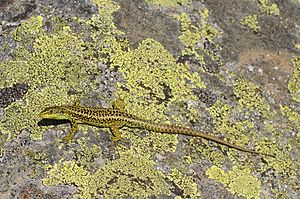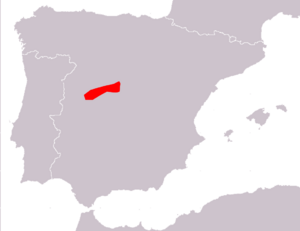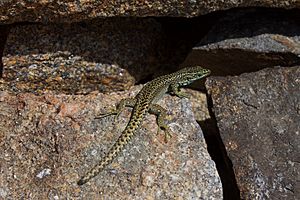Cyren's rock lizard facts for kids
Quick facts for kids Iberolacerta cyreni |
|
|---|---|
 |
|
| Conservation status | |
| Scientific classification | |
| Genus: |
Iberolacerta
|
| Species: |
cyreni
|
 |
|
| Synonyms | |
|
|
The Iberolacerta cyreni, also known as the Cyren's rock lizard, is a type of lizard found in Spain. It belongs to the family called Lacertidae. This lizard lives only in central Spain and is considered an endangered species. Scientists believe global warming is a big threat to it.
I. cyreni has special behaviors. For example, it can recognize other lizards of its own kind. It also has ways to control its body temperature.
Contents
About the Name
The first part of its name, "Iberolacerta," tells us where these lizards come from. They are native to Spain, which is part of the Iberian Peninsula.
The second part, "cyreni," is a way to honor a Swedish scientist named Carl August Otto Cyrén. He studied reptiles and amphibians.
What They Look Like
The Cyren's rock lizard can grow up to about 8 cm (3.1 in) long from its snout to the base of its tail. If you include the tail, it can be up to 24 cm (9.4 in) long.
Male lizards are often bigger and have larger heads than females. This is because bigger males might have more success finding mates. Females, on the other hand, have larger bellies. This helps them carry their eggs.
These lizards can be brown, or brown with a hint of green. They have dark brown spots that run in lines down their bodies. You can tell them apart from other rock lizards in western Spain because they don't have blue spots that look like eyes on their shoulders.
Family Tree of Lizards
Iberian rock lizards are part of a group called Iberolacerta. Over time, these lizards have spread out and then got separated by things like ice ages and mountains. This led to different types of lizards evolving.
Scientists think that many of these lizards became different species a long time ago. This might be because some areas acted as safe places during ice ages, protecting the lizards. Also, the many mountains in southern Europe created different habitats. This helped new species form.
In this lizard family, males and females often look different. This is called sexual dimorphism.
The Iberolacerta group includes many species. Some examples are the I. aurelio, I. cyreni, I. horvathi, and I. monticola.
Subspecies
There are two types of I. cyreni that scientists recognize:
- Iberolacerta cyreni castilliana (Arribas, 1996)
- Iberolacerta cyreni cyreni (L. Müller & Hellmich, 1937)
If you see a name in parentheses after a subspecies, it means that subspecies was first described under a different lizard group.
What They Eat
The Cyren's rock lizard mainly eats small creatures without backbones. This includes insects and spiders.
Where They Live
Iberolacerta lizards live in the mountains of the western Mediterranean. The I. cyreni specifically lives in the central mountain system of Spain. You can find them in places like the Sierra del Guadarrama, Sierra de Gredos, and Sierra de Bejar.
These lizards prefer damp, rocky areas near the tree line. But they can also be found in forests, shrublands, grasslands, and even plantations.
How They Behave
Recognizing Each Other
Lizards like I. cyreni can recognize other lizards of their own kind. This is important when they meet often or when it's helpful to know who's who.
Lizards often use chemicals to communicate. They have special sense organs and glands on their skin. They also leave waxy smells on rocks. These smells can tell other lizards things like how strong they are, their age, or even their color. Male rock lizards can tell the difference between their own scent and the scent of other males. This helps them identify groups of lizards.
Controlling Body Temperature
Controlling body temperature is very important for lizards like I. cyreni. It helps them stay healthy even when the temperature around them changes a lot. Many Iberolacerta lizards have adapted to cold places.
These lizards don't have one perfect body temperature. Instead, they have a range of temperatures that work best for them. Smaller lizards can heat up faster than bigger ones. This means smaller lizards might bask in the sun for shorter, more frequent times.
Rock lizards actively try to control their temperature. They might change how they face the sun or change their body position. They also choose specific spots to warm up or cool down. In very hot weather, they might spend more time trying to cool down. This can make them more open to predators. Even though controlling their temperature takes effort, it helps them survive in cold mountain areas.
Making Sounds
While many animals use sounds to communicate, we don't know as much about how reptiles use them. I. cyreni are known to use smells and sight to communicate. But new studies suggest they might also make sounds.
Female I. cyreni have been seen making sounds. They do this by quickly pushing air out of their lungs with their mouths open. Then they move their heads back and close their mouths. The sound is like short, nasal squeaks. They usually make three to seven squeaks at a time. Each squeak lasts about 122 milliseconds (a very short time).
We don't fully know why these lizards make sounds. But their sounds are similar to alarm calls or distress calls in other animals. This suggests they might be warning predators or other lizards.
How They Reproduce
Mating Habits
Male lizards' success in mating can depend on things like their head size, body size, color, and how active they are. I. cyreni have a mating system where both males and females have many partners. This means that a few males might have offspring with many females. This can be good for both sexes. Males can have more babies, and females can have more eggs hatch.
This type of mating might happen because they have short breeding seasons. Also, their home ranges overlap a lot, and there are many lizards in one area.
Female lizards don't always mate with the closest male. They might choose mates who live farther away. This could help them avoid inbreeding (mating with close relatives).
Having Successful Babies
For males, being active can show that they are strong and healthy. This helps them have more success in mating. Outside of the breeding season, males are less active to avoid predators. But during breeding season, they are very active. This helps them find females.
Also, males with longer tails might be able to bask in the sun closer to safe hiding spots. This makes them less likely to be caught by predators. A male's tail length is a good sign of how successful he will be at having offspring.
Protecting Them
The Cyren's rock lizard is an endangered species. One of the biggest threats to them is global climate change. As temperatures rise, it hurts species that are used to cool climates, like mountain lizards. Warmer temperatures can make it harder for their eggs to hatch. It can also limit how long they can be active without getting too hot.
Human activities also threaten their homes. Building roads and ski resorts can destroy their habitats.
Luckily, I. cyreni are protected in two special places: the Sierra del Guadarrama Natural Park and Sierra de Gredos Natural Park. These parks help these lizards reproduce and grow their populations.



